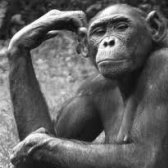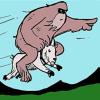My basic opinion of what they are hasn't changed much in the past decade. There have been all sorts of discoveries that validated my opinion of them being something that split off humans sometime early in the genus Homo. It was basically just looking at the fossil record with the assumption that there were multiple lineages. They found a habilis living at about the same time and place as Turkana Boy who was apparently going to grow into a large and powerful erectus that lived about 1.5 million years ago in Easter Africa. They also found a very tiny erectus skull nearby of the same time. They found a much more primitive fossil of Australopithecus sediba that wasn't much older that lived in Southern Africa. There were also a few types of robust Australopithecus living past the time of Turkana boy. The reason that time is important is because that is about when human ancestors seemed to stop relying on trees and they became more bipedal and that probably allowed them to expand into several new niches in Asia. At least one of those populations apparently became technological and dangerous hunters. Some of the others must have taken an avoidance strategy to have survived in the same area at the same time. Those would be a likely candidate for ancestor of bigfoot.
I would expect the ancestor of bigfoot to be one of the early groups that left Africa. There were probably multiple lineages that left. They were probably still genetically compatible and there may have been some gene flow between probably any of the different populations. Different lifestyles probably limited that. Modern humans aren't adapted to the same things so I could see many "wild" traits being preserved where they weren't in modern humans assuming interbreeding.
They probably also adapted their feet to be more flexible since the locked kneed arched foot that is so efficient on open ground is much less so in swamps and steep terrain. It might be in response to size. The arch probably breaks down after you reach a certain size. I think the foot flexibility argument is likely exaggerated because they are looking for ape characteristics. I would suspect that there is some confirmation bias. The footsteps that I heard sounded like a truck tire rolling and it was very unusual for a human walking. That makes me think the foot is relatively flexible. I expect they are rigid except under the weight of walking. I doubt it has anything whatsoever to do with ape feet being more flexible to make climbing easier. If that were true, you would expect the divergent big toe. It is probably an adaptation that better suits rough terrain. We have the joint so any amount of flexibility isn't out of the question. It would probably make walking less efficient if there were no stiffness.
Going down on all fours is probably easier for them than us. There is no reason to think they are knuckle walkers. No ancestor of ours ever was according to most conclusions after examining Ardipithecus ramidus. The implications of that are that chimps and likely gorillas evolved knuckle walking after being partially bipedal because they spend more time in trees. To efficiently climb a tree, very short legs and long arms are best. The long arms and short legs makes knuckle walking more efficient. Knuckle walking basically just strengthens the wrists which are the weak point. It isn't an ape feature. It is a derived or adapted feature that suits forested environments and is probably more related to having very short legs and long arms for climbing trees. They have that to some extent which is why I think they probably do it occasionally. Young ones obviously start out that way since I doubt they are born bipedal. It looks to me like they would be much better adapted to walking bipedally. There might be times like when staying down that they might run that way. It is probably wrong to see both the flexible foot and walking on all fours as ape features. They are just different ways of getting around that probably have their own sets of advantages.
I think Patty is usually a little over 6 feet tall maybe averaging about 6' 2" tall and straightened out she would be well over 6.5' feet tall. Her weight is probably about 600 pounds. There are possible errors with foot ruler method but I think it likely that my estimation is close but it is just an opinion. That would make males with a 17 inch footprint probably well over 7 feet tall and probably up to 800 pounds. I think she is probably heavier around the midsection than males just based on many reports. I would expect that 8' is probably a large male but there may be exceptionally large or tall ones. Those are probably the largest and outside the PNW they are probably smaller on average but still much larger than a normal person. I am much more skeptical about them living all over the place but they may have other populations. The only place I have much confidence in them living is from Northern California including the Sierras to southern British Columbia.
I think her "cone head" is exaggerated by hair. There are a few frames that suggest that. It doesn't appear to be much of a cone head from some angles. I didn't find the gif that looked like hair moving. There might be also be smearing or distortion from slow shutter.
They would logically have larger eyes and possibly other adaptations to nocturnal vision. Our possible encounter was in the middle of the night and sasquatch are very commonly observed out and about at night. I am still open to the possibility that the glow might be some combination of optical effect or something else like a tapetum. Some of them are very simple like a layer of guanine crystals.
Being covered with hair isn't surprising. We still have the same number of hair follicles as chimps do. They would also logically be cold adapted. I would expect that they would have plenty of time to develop warmer hair. That brings up one of the reasons that infrequent interbreeding with humans might not change them much. That would be one of the traits that would be maladaptive for their niche. They would likely lose many of the other human characteristics from a hybrid that aren't particularly helpful like greater language skills, finer dexterity of the hands, ached feet... That might explain how they would maintain the ability to interbreed longer without losing the aspects of their basic physiology that works better in the wild.
Some chimps make spears and they aren't humans. Some don't. Are the ones that don't hunt with spears not still chimps? Tools in humans are based on culture. We obviously have better dexterity to make fine tools out of rocks but that apparently wasn't true of all members of the genus Homo. Floresiensis is an example of one with a primitive wrist bone that suggests they lack the great dexterity of the thumb that is commonly called an opposable thumb. We also apparently have difference in the brain that give us greater dexterity. Fire is also cultural. We haven't necessarily been using it that long. It likely doesn't include all members of our genus. In their case, it would also make sasquatch much less stealthy. We pretty much need it to soften up food. Some "erectus" have enormous jaws and teeth, apparently to process more or coarser food. That argument that they don't use fire is really only an argument that might apply to modern humans. It doesn't really work for all members of the genus Homo.
I don't buy most of the 3 or 4 toed sightings as very credible but I wouldn't totally discount them. There are examples of human populations containing significant numbers of people with odd feet like the Doma people.
No neck is common in people with very muscular shoulders. Bigfoot seem to have an extreme case of that but it isn't that surprising even if it were genetically in the range of modern humans which I seriously doubt by the way. That pretty much answers the other points in Parn's quote.



